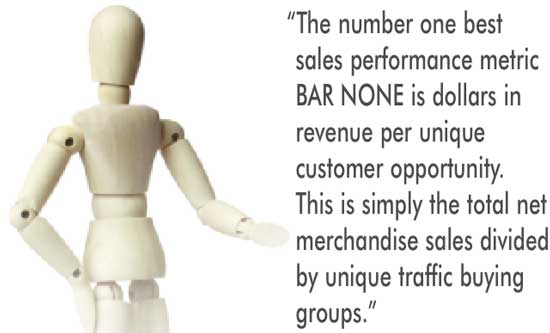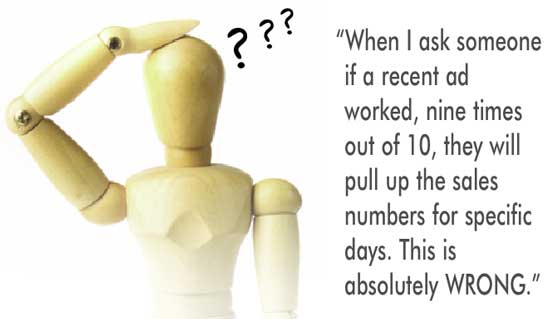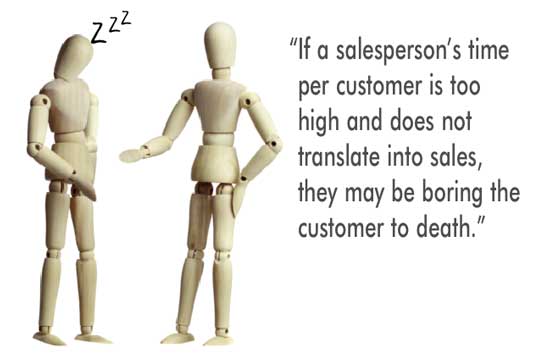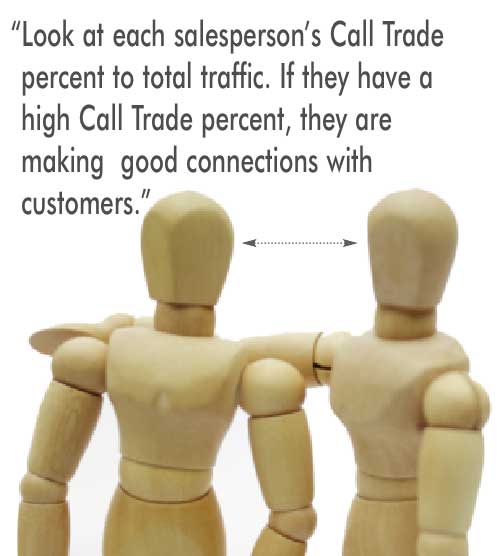I’m confused, I don’t know if I found my rope or lost my horse. Are you confused about sales metrics? Let’s make sales performance metrics really easy to understand.
Before delving into this discussion, I want to repeat my contention from the last issue of Furniture World that reviewing and printing sales metrics for your sales staff is NOT sales management or sales coaching. It’s what you learn from performance metrics that gives you insight into how to coach and what to coach.

Sales coaching is comprised of 4 parts. Plan, execute, review and coach. The plan is the selling system, sales training program or steps in the selling process. Execute is where the salesperson executes the plan on the sales floor with his/her customer. Review is capturing and analyzing sales performance metrics. Coaching is using these metrics along with your observation of the salesperson’s customer interactions to help coach long-term performance improvement.
This article will explore what most retailers are familiar with, the dependent sales performance metrics discussed in the September/October issue of Furniture World. Dependent metrics “depend” upon something happening. Dependent metrics can point to behaviors or skills that are or are not performed well by the salesperson. Precedent metrics are measurements of the actual skills and behaviors that when altered will change the dependent metrics. Most retailers are familiar with dependent metrics such as sales, traffic, close ratio, average sale etc..
Sales: The most common dependent metric is simply, sales. And for most home sector retailers sales is considered net merchandise sales without sales tax, delivery and service fees. Net sales is also most commonly merchandise sales after all cancellations, adjustments and exchanges. So, net sales is net merchandise only.
Many retailers also capture sales of services and special categories. Services can be delivery, warranty and mattress protectors. The most common special categories are bedding and accessories. Many stores also track sales of DEAD inventory that needs to be moved.
Average Sale/ Average Ticket: The next major dependent metric most stores capture is the average sale or average ticket amount. Average sale is simply total sales divided by the number of tickets. $65,000 in net sales with a total of 100 tickets would be an average of $650. per ticket.

Traffic Counting In Furniture Stores
Many stores do not count traffic but should. Traffic is a measure of unique visitors to the store. I recommend capturing unique buying groups rather than total foot traffic. A buying group could be mom, dad and 6 kids… that’s 8 people if you count foot traffic, but only one buying group. It is also recommended that unqualified traffic not be counted. Unqualified traffic is the UPS man, employees and sales reps. Traffic counts should be tracked by salesperson so you can see how effective a salesperson is with the opportunities you pay for and provide him/her.
When you count traffic I also recommend you capture traffic by time slots and days. This is a great way to ensure your staffing is RIGHT ON. Salespeople should not be going to lunch or dinner when traffic is high. Also, you do not want to staff your store on intuition, so validate the traffic numbers and staff accordingly.
One main reason to count traffic is to validate advertising results. When I ask retailers if one of their recent ads worked, nine times out of ten, they will pull up the sales numbers on specific days. This is absolutely WRONG. The goal of advertising is to drive qualified traffic into the store. The goal of the sales staff is to convert this traffic into sales. The goal of the merchandise department is to have desirable products at healthy margins available to sell.
So, when asked about an advertisements success or failure, one should immediately look at the traffic counts not sales. If an ad drives “Unqualified” traffic to the store for product that is not in the store’s merchandise plan “Sweet Spot”, conversion to sales will be difficult. That is NOT the salesperson’s fault. The accountability here rests with the advertising and merchandising departments.

This is why I say that retail is detail. If you are not into detail, you shouldn’t be in retail. The entire sales process is intimately interconnected with other departments like advertising and merchandising.
One more word on traffic. Traffic should be counted by advertising and marketing lead source. While the sales staff is with the customer why not ask, “How did you find out about us? Was there an ad that brought you in?” Then capture that data by advertising and marketing media source to validate your advertising and marketing effectiveness.
Hours Worked: Another metric to capture is hours worked. When you capture the hours worked, you can easily calculate sales per hour. You will see some salespeople working extra and some just the bare minimum. Sales per hour is total sales divided by hours worked. Sales per hour is a great indicator of hourly production.
When you capture hours worked you can calculate customers per hour and conversely hours per customer. If a salesperson’s time per customer is too high and does not translate into sales, they may be boring the customer to death. This can also be seen in a low Call-Trade percentage. (See Call Trade below) Some customers may not want to ask for Boring Bob when they return!
Call Trade Numbers: I recommend capturing Call Trade numbers. Call trade is sometimes called Be-Backs or Come-Backs. Call Trade can be return visits for the same purchase, repeat customers or referrals from raving fans. These are buying groups that return and ask for a specific salesperson by name. You will want to look at each salesperson’s Call Trade percent to total traffic. If they have a high Call Trade percent, they are making a good connection with the customer. If this number is unusually low compared to average and their close percent is average or below, then you have a relationship training and coaching opportunity. There may be a reason no one asks for this salesperson.
Unique Traffic: Unique traffic is a salesperson’s total traffic less the Call Trade or Be-Backs. This is the net traffic your store paid for and supplied to this salesperson. Then the question is what did he/she do with the opportunities you provided?
Ideally, you will want a salesperson to grow their Call Trade and rely less and less on your provided qualified traffic.
When you capture traffic counts, you can then calculate the close ratio for a salesperson. This is simply the percentage of overall customers that buy. So if a salesperson greets 100 people and sells 25, their close ratio or close percent is 25%. I suggest you calculate the close ratio based upon unique traffic buying groups.
Customer Contact Information: Many great sales floors also capture customer contact information from customers. Information like; name, phone, email, stated need and more. There are many easy non-threatening ways to do this. This information then forms the basis for your store’s private sales events (a zero advertising expenditure). I suggest tallying the number of qualified customer contact information captures per salesperson. A name and no phone or email is unqualified. If a salesperson has a traffic count of 100, and writes 25 tickets, that leaves 75 non-buyers. How many of these 75 did the salesperson obtain customer contact information? You cannot execute easy monthly private sales without this information, nor can your salespeople validate the claim they are following up with non-buyers.
 Margin:
Margin: Margin in most instances SHOULD NOT be a salesperson performance metric. Margin is a merchandising department accountability metric. There are some exceptions.
Items Per Ticket: Items per ticket should also be tracked. This metric gives great insight into a salesperson’s ability to grow the sale beyond the stated need.
Disconnect Rate: Another huge metric that is worth looking at is the disconnect or “Just Looking” rate at the door. What percentage of a salesperson’s unique traffic is disconnecting at the door? A high number indicates poor greeting skills.
You will notice right away that some metrics are time sensitive and some are not. If you happen to have part time and full time salespeople, traffic counts will vary as will hours worked. The sales per hour metric as well as the close percent and average sale are independent of time worked while total net sales, traffic and tickets is reflective of hours worked.
Dollars In Revenue Per Unique Customer Opportunity: The number one best sales performance metric BAR NONE is dollars in revenue per unique customer opportunity. This is simply the total net merchandise sales divided by unique traffic buying groups.
I am sure you’ve seen an all you can eat buffet salesperson before. This buffet salesperson will greet, assess and drop a customer if there isn’t an immediate buying signal. The buffet salesperson tries to gobble up as much traffic as possible.
If Jim has 100 buying groups in a month and produces $75,000 in net sales and Mark utilizes 165 buying groups to produce $100,000 in sales… Who is the best salesperson? Many retailers would say that Mark is the best salesperson simply because he has more sales volume. It’s not the top salesperson in volume that is always the best salesperson on your floor. The best salesperson is the salesperson with the highest revenue per buying group.
Jim’s revenue per buying group is $75,000 divided by 100 or $750. Jim brings in revenue of $750 on average for every unique buying group he greets. And conversely, Mark’s revenue per customer is $100,000 divided by 165 or $606. Jim makes the store 23.7% more revenue for each customer buying group.
Jim and Mark’s employer invests a lot of money in advertising, occupancy, warehouse and delivery, sales support, and SG&A expense per unique customer opportunity. Mark is wasting this money by burning through customers like an all you can eat buffet. This store really needs more Jim’s on the floor! Or they need to slow Mark down. Preferably, do both.
ready, set, manage!
Take all of these metrics and calculate a total, an average, a maximum and a minimum. Now you are ready to separate the wheat from the chaff.
If your range of performance from maximum to minimum in any or all of these numbers is high it should scare you because you are losing sales. It also means that each of your customers is receiving a vastly different experience based upon who greets them. A wide range of performance points to a sales team using different selling systems, or a sales floor that has no selling system at all. This is a recipe for poor customer service and lower than necessary store sales. Stores with a wide range of performance have a huge potential for sales increases.
Low Average Sale: What if a salesperson has a low average sale over time compared to average? They probably are not relational, not building trust, moving too fast, failing to grow the ticket. Their Call Trade is probably low too. They probably have a low item count per ticket as well.
Low Close Ratio: What if a salesperson has a low close ratio over time compared to average? They are probably failing to qualify and/or ask for the sale. Could be a “greet and retreat” salesperson or be blowing the greeting causing a high disconnect rate at the door.
Low Average Sale: What if a salesperson has a low average sale and high close ratio over time compared to average? They could be selling just what the customer asks for and no more. Perhaps they are just selling the advertised items or the low priced leaders… the easy sales. They may not be able to step-up. Look for the low average sale amount and low items per ticket. Usually you will also see low services and/or low warranty sales for these salespeople. High warranty and services indicate a relational trust building salesperson.
High Average Sale & Low Close Ratio: What if a salesperson has a high average sale and low close ratio over time compared to average? They may be trolling; taking customers and then dropping them if there is no indication they are buying A LOT and buying right now. This salesperson may be great at big tickets and give little value to the single item or low ticket customer.
CONCLUSION
All of this data capture seems like a daunting task at first. However, the benefits and rewards far outweigh the effort. In fact, one daily sheet of paper that each salesperson fills out could capture all the desired data. And then it is simply a matter of entering the data each day into a program that produces the desired reports.
Sales performance metrics alone are not coaching… but metrics can and do indicate where to look as you review sales interactions on the floor. Effectively coaching without this data is a near impossibility. The insight you gain will have you coaching the High Value Targets effectively and with great clarity.
Offer: Furniture World readers can sign up to take a free Sales Manager Effectiveness Quiz and receive an in depth report showing opportunities for improvement or validating the fact you are doing it right.
To participate, log on to
www.IntegrityBusinessCoaching.com and select “SALES MANAGER QUIZ”? on the "Free Tools" menu on the top menu bar. Fill out the online form and you will be contacted to set up for your free online quiz(s).
Founder of Integrity Business Coaching, Hal McClamma has over 30-years in the home furnishings, appliance and electronics industry. He has owned successful furniture stores and sleep shops. McClamma has been a distribution center manager, single and multiple store manager and company VP for Havertys Furniture, Barrow Furniture, Maas Brothers, Burdines and Jordan Marsh. Contact Hal at Hal@IntegrityBusinessCoaching.com or call 334.470.9999.